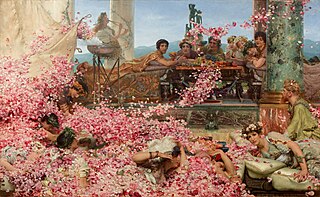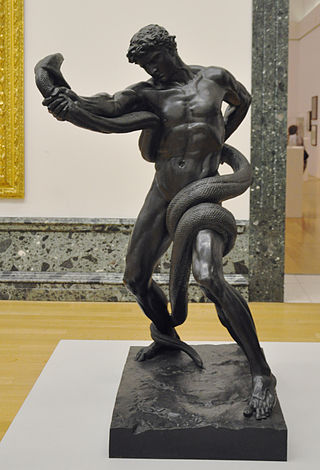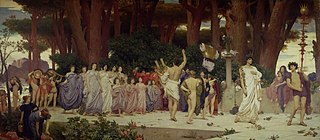
Sir Lawrence Alma-Tadema,, RWS was a Dutch painter who later settled in the United Kingdom, becoming the last officially recognised denizen in 1873. Born in Dronryp, the Netherlands, and trained at the Royal Academy of Antwerp, Belgium, he settled in London, England in 1870 and spent the rest of his life there.

The Roses of Heliogabalus is an 1888 painting by the Anglo-Dutch artist Sir Lawrence Alma-Tadema depicting the young Roman emperor Elagabalus hosting a banquet.

John William Waterhouse was an English painter known for working first in the Academic style and for then embracing the Pre-Raphaelite Brotherhood's style and subject matter. His paintings are known for their depictions of women from both ancient Greek mythology and Arthurian legend. A high proportion depict a single young and beautiful woman in a historical costume and setting, though there are some ventures into Orientalist painting and genre painting, still mostly featuring women.

Frederic Leighton, 1st Baron Leighton,, known as Sir Frederic Leighton between 1878 and 1896, was a British Victorian painter, draughtsman, and sculptor. His works depicted historical, biblical, and classical subject matter in an academic style. His paintings were enormously popular and expensive, during his lifetime, but fell out of critical favour for many decades in the early 20th century.

Harry Bates was a British sculptor. He was elected to the Royal Academy in 1892 as A.R.A. and was an active, if intermittent, member of the Art Workers Guild. He was a central figure in the British movement known as New Sculpture.

John William Godward was an English painter from the end of the Neo-Classicist era. He was a protégé of Sir Lawrence Alma-Tadema, but his style of painting fell out of favour with the rise of modern art.

Henrietta Emma Ratcliffe Rae was a British painter of the late Victorian era, who specialised in classical, allegorical and literary subjects. Her best-known painting is The Lady with the Lamp (1891); depicting Florence Nightingale at Scutari.

Cymon and Iphigenia is an oil on canvas painting by Frederic Leighton, 1st Baron Leighton. The painting does not bear a date but was first exhibited at the Royal Academy of Arts, London, in 1884. The Art Gallery of New South Wales in Sydney, Australia, purchased it at a Christie's auction in London in 1976.

An Athlete Wrestling with a Python was the first of three bronze sculptures produced by the British artist Frederic Leighton. Completed in 1877, the sculpture was a departure for Leighton, and heralded the advent of a new movement, New Sculpture, taking realistic approach to classical models. It has been described as a "sculptural masterpiece" and as "possibly Leighton's greatest contribution to British art". Despite its indebtedness to the Classical tradition, it can be understood as one of the first stirrings of modern sculpture in Britain as well as in Europe. The Athlete was arguably the most influential piece of English sculpture of the 19th century.

A Reading from Homer is an oil-on-canvas painting executed in 1885 by the English artist Lawrence Alma-Tadema. It depicts an imaginary festival scene from ancient Greece with youth reading poetry to a small audience on a marble balcony overlooking the sea. The painting has been in the collection of the Philadelphia Museum of Art since 1924.
Crenaia, the Nymph of the Dargle is an oil painting by Frederic Leighton, first exhibited in 1880. It is in the collection of Juan Antonio Pérez Simón.

The Fisherman and the Syren is an oil painting by Frederic Leighton, first exhibited in 1858. It is a composition of two small full-length figures, a mermaid clasping a fisherman round the neck. The picture is in the collection of the Bristol Museum & Art Gallery.

Venus Disrobing for the Bath is an oil painting by Frederic Leighton, first exhibited in 1867.

Actaea, the Nymph of the Shore is an oil painting by Frederic Leighton, first exhibited in 1868.

Winding the Skein is an oil painting by Frederic Leighton, first exhibited in 1878.

Nausicaa is an oil painting by Frederic Leighton, first exhibited in 1878.

The Music Lesson is an oil painting by Frederic Leighton, first exhibited in 1877.

The Daphnephoria is an oil painting by Frederic Leighton, first exhibited in 1876.

The Art Collection of Henry Gurdon Marquand was a collection of antiques and paintings owned by Henry Gurdon Marquand, the second president of the Metropolitan Museum of Art, until his death in 1902.

Psamathe is an oil painting by Frederic Leighton, first exhibited in 1880.




















